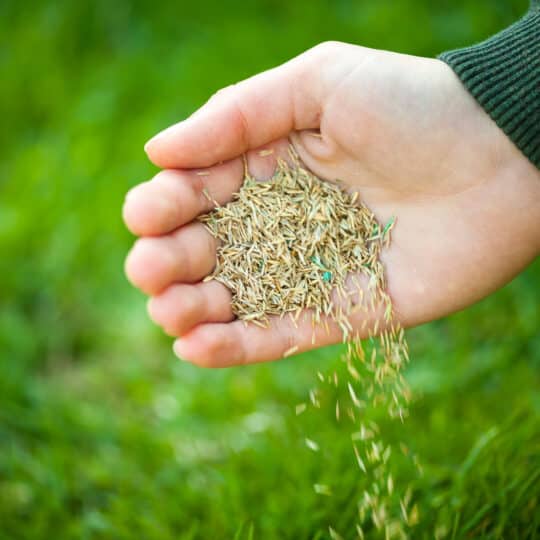When to Overseed Your Lawn
Timing is Everything
Posted
April 4, 2024

With the lawn waking up this time of year, you should see its lushness and vibrancy bouncing back after a dormant winter. However, some spots may look a little less dense than others. Depending on how the winter went, you may also notice some bare patches. Not to worry, there’s a way to help improve the density of your grass and enhance the overall appearance. One way is overseeding, but the trick is to determine when to overseed your lawn.
What is Overseeding
Overseeding is the process of spreading grass seed over an existing lawn. This helps improve grass density, fill in bare or thinning patches, and enhance the overall appearance of the lawn. Overseeding helps rejuvenate the grass without the need for major renovation or relaying turf.
The overseeding process looks like this:
- Choose a high-quality grass seed that is suitable for your climate.
- Mow the lawn and remove any debris.
- Use a rake to loosen the top layer of soil and remove excess thatch.
- If the soil is compacted, consider aerating.
- Use a broadcast spreader to evenly distribute the grass seed over the entire lawn.
- For thin or bare patches, overseed more for better coverage.
- Lightly rake the soil to ensure good seed contact.
- Water to keep the newly seeded area moist until the seeds germinate.
- As the new grass grows, gradually reduce the watering frequency but increase the amount to encourage deep root growth.
- Avoid mowing the new grass until it reaches a few inches high.
If you want to make the most of overseeding, consider the time of year. Even if you notice bare spots, timing the seed application depends on the grass type.
When to Overseed Your Lawn
Different types of grass have varying growth habits and ideal conditions. Understanding your grass type is essential for determining the best time to overseed.
- Cool-season grasses (Kentucky bluegrass, fescues, and perennial ryegrass) thrive in cooler temperatures. Overseeding in the early fall as temperatures begin to cool. This timing allows the seeds to germinate and establish before winter dormancy.
- Warm-season grasses (Bermuda grass, zoysia grass, and St. Augustine grass) prefer warmer temperatures. Overseed in late spring or early summer when soil temperatures are warm and there is plenty of sunlight for optimal germination and growth.
No matter what type of grass you have, avoid overseeding during periods of extreme heat or cold. This can stress the grass and hinder germination. Aim for mild temperatures for the best results.
If you need help determining your grass type and the best process for overseeding, contact the lawn care specialists at Cardinal Lawns for assistance. Not only do we understand the timing for different types of grass, but we can help maintain a healthy, vibrant lawn all year long.
Special Offer for New Customers
Two Free Lawn Care Treatments
Hurry! Offer Expires April 30, 2025